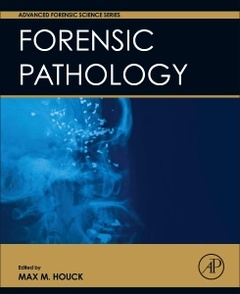Description
Forensic Pathology
Advanced Forensic Science Series
Coordinator: Houck Max M.
Language: English
Subjects for Forensic Pathology:
Support: Print on demand
Description
/li>Contents
/li>Biography
/li>Comment
/li>
Forensic Pathology, the latest volume in the Advanced Forensic Science series that grew out of the recommendations from the 2009 NAS Report serves as a graduate level text for those studying and teaching forensic pathology, and is an excellent reference for forensic pathologists? libraries or for use in their casework.
Coverage includes postmortem interval, autopsy, trauma, causes of death, identification, and professional issues. Edited by a world-renowned leading forensic expert, this series provides a long overdue solution for the forensic science community.
Section 1. Overview
Introduction
Principles of Forensic Science
Forensic Classification of Evidence
Interpretation/The Comparative Method
Clinical Forensic Medicine—Overview
Forensic Pathology—Principles and Overview
History of Forensic Sciences
Key Terms
Review Questions
Discussion Questions
Section 2. Postmortem Interval
Introduction
Postmortem Interval
Early and Late Postmortem Changes
Estimation of the Time Since Death
Vital Reactions and Wound Healing
Key Terms
Review Questions
Discussion Questions
Section 3. Autopsy
Introduction
External Postmortem Examination
Autopsy
Histopathology
Postmortem Imaging
Key Terms
Review Questions
Discussion Questions
Section 4. Trauma
Introduction
Blunt Injury
Burns and Scalds
Asphyctic Deaths—Overview and Pathophysiology
Strangulation
Traumatic and Postural Asphyxia, Physical Restraint
Immersion Deaths
Sharp Trauma
Systemic Response to Trauma
Gunshot Wounds
Domestic Violence
Child Abuse
Defense Wounds
Self-Inflicted Injury
Torture
Traffic Injuries and Deaths
Key Terms
Review Questions
Discussion Questions
Section 5. Causes of Death
Introduction
Sudden Natural Death
Sudden Infant Death Syndrome (SIDS)
Hyperthermia and Hypothermia
Electrocution and Lightning Strike
Deaths Associated with Medical Procedures
Neonaticide
Key Terms
Review Questions
Discussion Questions
Section 6. Identification
Introduction
Identification
Forensic Age Estimation
Personal Identification in Forensic Anthropology
Identification of the Living
The National Missing and Unidentified Persons System (NamUs)
Disaster Victim Identification
Airplane Crashes and Other Mass Disasters
Key Terms
Review Questions
Discussion Questions
Section 7. Professional Issues
Introduction
Crime Scene to Court
Expert Witness Qualifications and Testimony
Health and Safety
Deaths in Custody
Suicide
National Association of Medical Examiners (NAME)
Key Terms
Review Questions
Discussion Questions
- Provides basic principles of forensic science and an overview of forensic pathology
- Contains sections on postmortem interval, autopsy, trauma, causes of death, and identification
- Includes a section on professional issues, such as crime scene to court, expert witness testimony, health and safety, deaths in custody, and suicide
- Incorporates effective pedagogy, key terms, review questions, discussion questions, and additional reading suggestions
These books may interest you

Forensic Anthropology 85.01 €

Digital and Document Examination 98.24 €

Forensic Fingerprints 68.41 €

